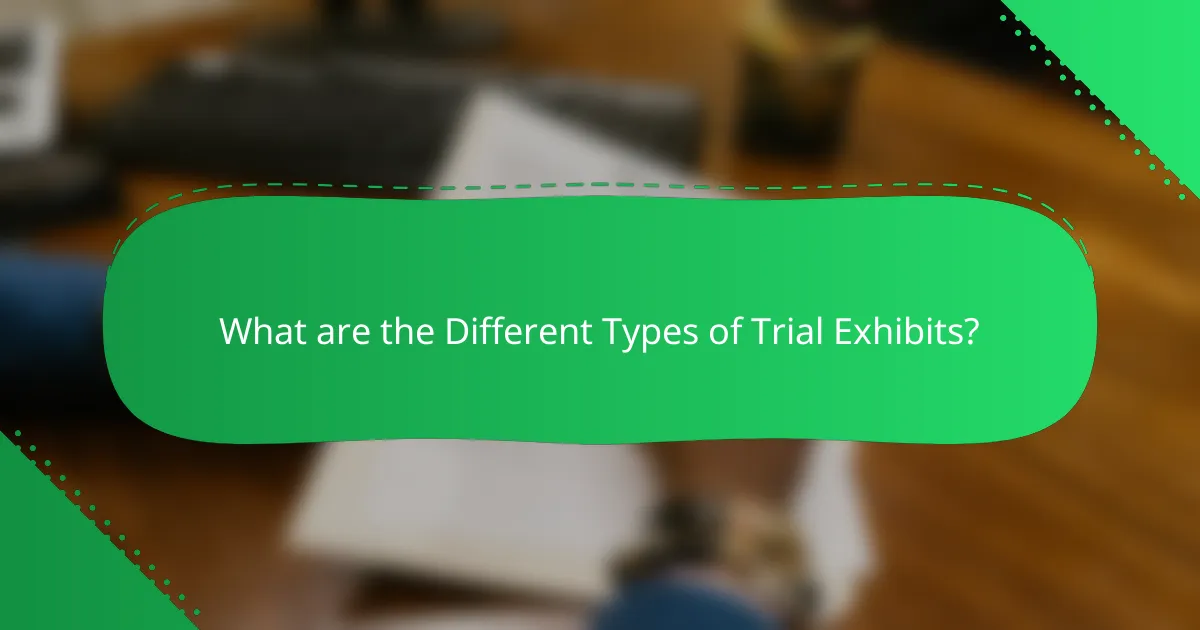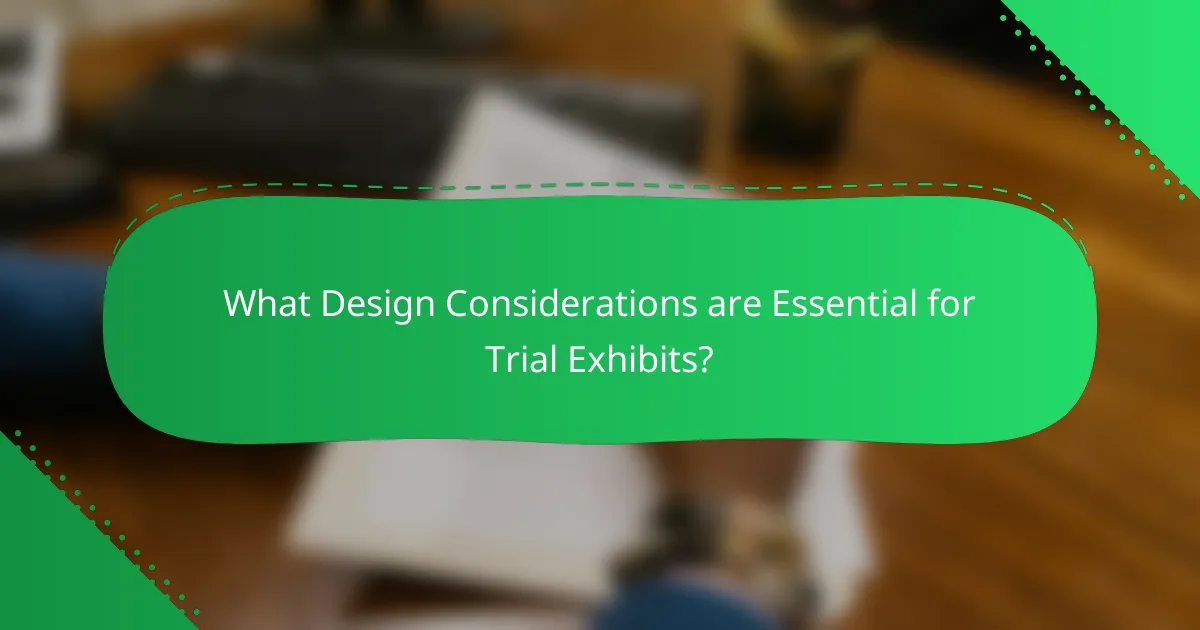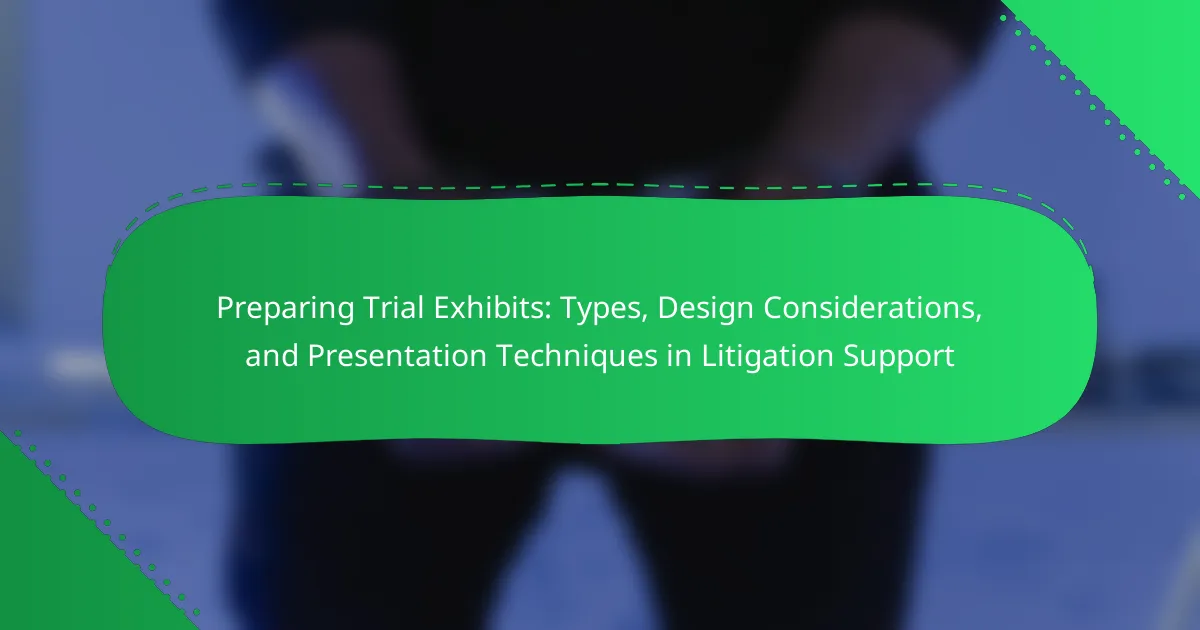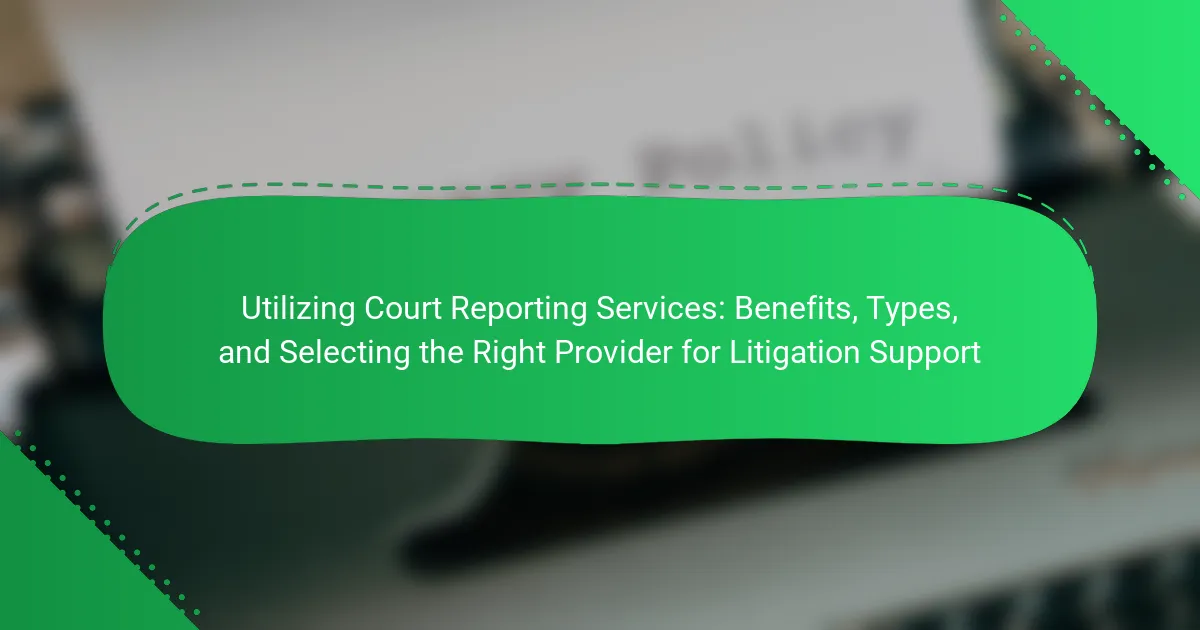Trial exhibits are tangible items presented in court to support a party’s case in litigation. This article covers the various types of trial exhibits, including documentary, physical, demonstrative, and digital exhibits, each serving a specific purpose in conveying evidence. Key design considerations for trial exhibits focus on clarity, visual appeal, relevance, and accessibility to ensure effective communication with the judge and jury. Additionally, the article discusses effective presentation techniques such as organization and engagement, which enhance understanding and retention of information during trials. Understanding these elements is crucial for legal professionals aiming to optimize their litigation support strategies.

What are Trial Exhibits in Litigation Support?
Trial exhibits in litigation support are tangible items presented in court to support a party’s case. They can include documents, photographs, videos, or physical objects. These exhibits help to illustrate evidence and clarify complex information for the judge and jury. The presentation of trial exhibits is crucial for effective communication during a trial. Properly prepared exhibits can enhance the persuasiveness of a legal argument. Courts generally require that exhibits be disclosed ahead of time and admitted into evidence. This process ensures that all parties are aware of what will be presented. Trial exhibits must meet specific legal standards to be admissible. They play a vital role in the overall strategy of litigation support.
How do Trial Exhibits function within a legal context?
Trial exhibits serve as tangible evidence presented during legal proceedings. They help illustrate facts, support arguments, and clarify complex information for the judge and jury. Trial exhibits can include documents, photographs, charts, and physical objects. Each exhibit must be relevant to the case and properly authenticated to be admissible in court. The legal framework governing trial exhibits is outlined in the Federal Rules of Evidence. These rules dictate how exhibits should be introduced and challenged. Effective use of trial exhibits can significantly influence the outcome of a case. They enhance the narrative presented by attorneys, making it easier for the court to understand the evidence.
What types of information are typically included in Trial Exhibits?
Trial exhibits typically include documents, photographs, diagrams, and physical evidence. Documents can consist of contracts, emails, or reports relevant to the case. Photographs may depict crime scenes or injuries. Diagrams often illustrate timelines or relationships between parties. Physical evidence can include weapons or other tangible items. Each type of information serves to support claims or defenses in litigation. The inclusion of these elements helps to provide clarity and context to the case presented in court.
How do Trial Exhibits contribute to case arguments?
Trial exhibits enhance case arguments by providing tangible evidence that supports claims. They visually present facts and information to the jury. This clarity helps jurors understand complex issues. For example, charts can simplify financial data. Photographs can depict crime scenes or injuries. Documents can validate witness statements or contracts. The use of trial exhibits can increase persuasion. Research shows that jurors are more likely to remember visual information. Effective exhibits can significantly influence case outcomes by reinforcing legal arguments.
Why is the preparation of Trial Exhibits important?
The preparation of trial exhibits is crucial for effectively presenting evidence in court. Well-prepared exhibits enhance clarity and understanding for the judge and jury. They help to illustrate key points in a case, making complex information more accessible. Properly designed exhibits can significantly influence the outcome of a trial. Research shows that visual aids improve retention of information, aiding in persuasive arguments. Accurate preparation also ensures compliance with legal standards and procedures. This minimizes the risk of objections or dismissals during trial. Overall, the strategic preparation of trial exhibits is a vital component of successful litigation support.
What impact do well-prepared Trial Exhibits have on jury perception?
Well-prepared trial exhibits significantly enhance jury perception. They provide clear, organized, and visually appealing information. This clarity aids jurors in understanding complex evidence. A well-designed exhibit can emphasize key points effectively. Research indicates that jurors are more likely to retain information presented visually. Studies show that visuals can increase information retention by up to 65%. Therefore, trial exhibits that are well-prepared influence jurors’ interpretations and decisions positively.
How can effective Trial Exhibits influence the outcome of a trial?
Effective trial exhibits can significantly influence the outcome of a trial by enhancing understanding and retention of key information. They present complex data in a clear and engaging manner. This clarity helps jurors and judges grasp critical points quickly. Visual aids, such as charts and timelines, can make arguments more persuasive. Research indicates that jurors are more likely to remember information presented visually. In a study by the National Center for State Courts, visual evidence improved juror comprehension by 40%. Additionally, well-designed exhibits can evoke emotional responses, swaying opinions. Effective trial exhibits ultimately support the narrative of the case, making them crucial for favorable verdicts.

What are the Different Types of Trial Exhibits?
Trial exhibits can be categorized into several types. These include documentary exhibits, which consist of written materials such as contracts and reports. Physical exhibits are tangible items presented to the court, like weapons or clothing. Demonstrative exhibits are visual aids that illustrate evidence, such as charts or diagrams. Digital exhibits encompass electronic files, including videos and presentations. Each type serves a specific purpose in conveying information to the judge and jury. The effective use of these exhibits can significantly impact the outcome of a trial.
What categories of Trial Exhibits are commonly used?
Common categories of trial exhibits include documents, photographs, diagrams, and physical evidence. Documents often consist of contracts, emails, or reports relevant to the case. Photographs can capture crime scenes, injuries, or objects pertinent to the litigation. Diagrams may illustrate timelines, relationships, or the layout of locations involved. Physical evidence includes items like weapons or samples that support claims. Each category serves to provide clarity and support arguments during a trial.
How do documentary exhibits differ from demonstrative exhibits?
Documentary exhibits consist of actual documents, records, or written materials presented as evidence. They provide direct proof of facts through written statements, contracts, or correspondence. Demonstrative exhibits, on the other hand, are visual aids created to illustrate or clarify evidence. They include charts, models, or diagrams that help convey complex information. Documentary exhibits rely on existing documents, while demonstrative exhibits are often created specifically for the trial. The distinction lies in their function; documentary exhibits authenticate facts, whereas demonstrative exhibits enhance understanding.
What role do physical exhibits play in a trial?
Physical exhibits serve as tangible evidence in a trial. They help to illustrate facts and support arguments presented by both parties. Physical exhibits can include documents, photographs, models, or any objects relevant to the case. Their primary role is to enhance the jury’s understanding of the evidence. Jurors often rely on visual aids to process complex information. Studies show that jurors are more likely to remember evidence presented through physical exhibits. They also provide a persuasive element, influencing the jury’s perception of credibility. In summary, physical exhibits are crucial for effective communication in a trial.
What considerations should be made when selecting Trial Exhibits?
When selecting trial exhibits, relevance to the case is crucial. Exhibits must support the arguments being made. Clarity and simplicity are also important. Complex exhibits can confuse jurors. Authenticity is another key consideration. Exhibits should be verifiable and credible. The admissibility of exhibits must be ensured. They should comply with legal standards. Lastly, consider the visual impact. Engaging visuals can enhance understanding and retention.
How does the relevance of an exhibit affect its selection?
The relevance of an exhibit significantly influences its selection in litigation support. Exhibits must directly relate to the case to be considered useful. Relevant exhibits help establish facts, support arguments, and clarify issues for the jury. Courts often exclude irrelevant exhibits to maintain focus on pertinent information. A study by the National Center for State Courts emphasizes that relevance determines an exhibit’s admissibility. Thus, selecting relevant exhibits increases the chances of persuasive communication in court.
What factors determine the admissibility of Trial Exhibits?
The admissibility of trial exhibits is determined by relevance, authenticity, and compliance with rules of evidence. Relevance means the exhibit must relate to a fact that is significant to the case. Authenticity requires that the exhibit is what it claims to be, often supported by witness testimony or documentation. Compliance with rules of evidence includes ensuring the exhibit does not violate any legal standards, such as hearsay rules. These factors are essential for ensuring that the evidence presented is both credible and applicable in court.

What Design Considerations are Essential for Trial Exhibits?
Essential design considerations for trial exhibits include clarity, visual appeal, and relevance. Clarity ensures that information is easily understood by jurors. Visual appeal captures attention and aids retention of information. Relevance connects the exhibit to case themes and arguments. Additionally, simplicity prevents overwhelming jurors with excessive details. Consistent formatting enhances professionalism and credibility. High-quality images and graphics improve engagement and comprehension. Finally, accessibility ensures that all jurors can view and understand the exhibit. These considerations are crucial for effective communication in a trial setting.
How can clarity and readability enhance Trial Exhibits?
Clarity and readability enhance trial exhibits by making information easily accessible to jurors. Clear visuals and concise text improve comprehension. This allows jurors to quickly grasp key points. Enhanced readability reduces the risk of misinterpretation. Studies show that well-designed exhibits increase retention of information. For example, a study by the National Center for State Courts found that jurors perform better with clear, organized exhibits. Overall, clarity and readability significantly improve the effectiveness of trial exhibits in conveying complex information.
What design elements are crucial for effective visual communication?
Key design elements for effective visual communication include clarity, contrast, alignment, repetition, and hierarchy. Clarity ensures that the message is easily understood. Contrast helps in distinguishing elements and emphasizes important information. Alignment creates a sense of organization and structure. Repetition reinforces visual consistency and strengthens brand identity. Hierarchy guides the viewer’s attention to the most critical information first. These elements are essential in creating impactful visuals that convey information effectively. Studies show that visuals can increase retention of information by up to 65%, highlighting the importance of these design elements in communication.
How does the choice of colors and fonts impact viewer engagement?
The choice of colors and fonts significantly impacts viewer engagement in trial exhibits. Colors evoke emotions and can influence perceptions. For instance, blue is often associated with trust, while red can denote urgency. Fonts also play a crucial role; readable fonts enhance comprehension and retention. According to a study by the University of Minnesota, the right font can improve readability by up to 20%. Engaging designs utilize contrasting colors to draw attention to key information. Consistency in font usage across exhibits fosters a professional appearance, enhancing credibility. Ultimately, thoughtful color and font choices can lead to better audience engagement and understanding.
What are best practices for the layout of Trial Exhibits?
Best practices for the layout of trial exhibits include clarity, organization, and visual appeal. Clear labeling helps jurors quickly identify relevant information. Organizing exhibits chronologically or thematically enhances comprehension. Using consistent fonts and colors improves readability. Visual elements, such as charts or graphs, can simplify complex data. Each exhibit should focus on one key point to avoid confusion. Adequate spacing prevents overcrowding and maintains attention. Additionally, practice presenting each exhibit to ensure smooth delivery during the trial. These practices are supported by guidelines from the American Bar Association on effective trial presentation.
How should information be organized for maximum impact?
Information should be organized logically and hierarchically for maximum impact. This structure allows audiences to easily follow the narrative. Start with a clear introduction that outlines the main points. Use headings and subheadings to categorize information effectively. Each section should contain concise, relevant details. Visual aids such as charts and graphs enhance understanding. Consistent formatting aids in readability and retention. Prioritize the most critical information at the beginning of each section. This approach aligns with cognitive principles of information processing. Research shows that well-organized information increases retention by up to 50%.
What techniques can be used to highlight key points in Trial Exhibits?
Techniques to highlight key points in trial exhibits include using bold text, color coding, and bullet points. Bold text draws attention to crucial information. Color coding helps differentiate between categories or importance levels. Bullet points simplify complex information for clarity. Additionally, using large fonts ensures readability from a distance. Visual aids like charts or graphs can effectively summarize data. Annotations can provide context or explanations directly on the exhibit. Lastly, consistent formatting across exhibits enhances overall comprehension. These techniques are widely recognized in legal presentation best practices.

What Presentation Techniques are Effective for Trial Exhibits?
Effective presentation techniques for trial exhibits include clarity, organization, and engagement. Clarity ensures that the information is easily understood by jurors. Using simple language and legible fonts enhances comprehension. Organization involves structuring exhibits logically, guiding viewers through the narrative. Engaging the audience can be achieved through visual aids, such as charts and videos, which can illustrate complex information. Additionally, interactive elements, like touchscreens, may enhance juror involvement. Studies show that well-designed visual presentations can improve retention of information by up to 65%.
How can technology enhance the presentation of Trial Exhibits?
Technology can enhance the presentation of trial exhibits through various tools and techniques. Digital displays allow for high-resolution visuals that capture attention. Interactive presentations engage jurors by allowing them to explore evidence. Video evidence can effectively convey complex information in a digestible format. Virtual reality can simulate environments or scenarios relevant to the case. Additionally, software tools can organize and annotate exhibits for clarity. These advancements improve understanding and retention of critical information during trials. Studies show that jurors respond better to visually appealing and interactive content, leading to more informed decision-making.
What tools are available for creating digital Trial Exhibits?
Digital trial exhibits can be created using various tools. Commonly used software includes Adobe Acrobat for PDF creation and editing. Microsoft PowerPoint is also popular for presentations. TrialDirector is specifically designed for managing and presenting trial exhibits. Other tools include Sanction, which offers case management features. Additionally, software like CaseGuard provides video and audio exhibit capabilities. Each of these tools facilitates the organization and display of evidence in a digital format.
How does the use of multimedia influence audience engagement?
Multimedia enhances audience engagement by appealing to multiple senses. It combines visuals, audio, and text to create a more immersive experience. Research shows that presentations using multimedia can increase retention rates by up to 60%. Engaging visuals can capture attention more effectively than text alone. Audio elements can reinforce key messages and create emotional connections. Interactive components encourage active participation, making the audience more involved. In trial settings, multimedia can clarify complex information, aiding comprehension. Overall, multimedia fosters a dynamic interaction, leading to improved audience engagement.
What strategies can be employed for effective delivery of Trial Exhibits in court?
Effective delivery of trial exhibits in court can be achieved through several strategies. First, organize exhibits logically to align with the case narrative. This helps jurors follow the argument clearly. Second, utilize visual aids, such as charts or diagrams, to enhance understanding. Visuals can simplify complex information. Third, practice the presentation to ensure smooth delivery and familiarity with the materials. This builds confidence and reduces errors. Fourth, engage the jury by explaining the significance of each exhibit. This connection aids retention and comprehension. Fifth, ensure all exhibits are properly labeled and easily accessible during the trial. This reduces delays and confusion. Finally, use technology effectively, such as presentation software, to display exhibits clearly. This modern approach can captivate the jury’s attention.
How can attorneys prepare witnesses to present Trial Exhibits?
Attorneys can prepare witnesses to present trial exhibits by conducting thorough pre-trial preparation sessions. These sessions should include a detailed review of the exhibits and their relevance to the case. Witnesses should be trained on how to explain the exhibits clearly and concisely. Role-playing can help witnesses practice presenting the exhibits in a courtroom setting. Attorneys should also address potential questions that may arise during the presentation. Familiarity with the exhibits will boost the witness’s confidence. Clear communication about the importance of each exhibit is essential. Additionally, attorneys should ensure that witnesses understand the legal context surrounding the exhibits. This preparation can lead to a more effective presentation during the trial.
What role does storytelling play in the presentation of Trial Exhibits?
Storytelling plays a crucial role in the presentation of trial exhibits. It helps to create a narrative that connects the evidence to the case. A well-crafted story can engage jurors and make complex information more relatable. This connection enhances understanding and retention of key facts. Research indicates that narratives can increase persuasive impact in legal settings. For instance, a study by the American Psychological Association found that stories can influence juror decision-making. Thus, effective storytelling in trial exhibits can lead to more favorable outcomes in litigation.
What are some practical tips for preparing Trial Exhibits?
To prepare effective trial exhibits, focus on clarity and relevance. Organize exhibits logically to support your case narrative. Use high-quality visuals to enhance understanding. Label each exhibit clearly with a descriptive title and number. Ensure all text is legible, using appropriate font sizes and colors. Keep exhibits concise, avoiding unnecessary information. Practice presenting exhibits to ensure smooth delivery during trial. Review all exhibits for accuracy and compliance with court rules. Following these tips can significantly improve the impact of your trial exhibits.
How can one ensure that Trial Exhibits are clear and persuasive?
To ensure that trial exhibits are clear and persuasive, one must focus on simplicity and relevance. Clear visuals enhance understanding. Use high-quality images and legible fonts. Limit text to essential information. Organize content logically to guide the viewer’s attention. Highlight key points to emphasize critical information. Consistency in design elements fosters professionalism. Proper labeling of exhibits aids in clarity. Research shows that well-designed exhibits can significantly influence jury perceptions. A study by the National Center for State Courts indicates that visual aids improve retention and comprehension in legal contexts.
What common pitfalls should be avoided when preparing Trial Exhibits?
Common pitfalls to avoid when preparing trial exhibits include lack of organization, unclear labeling, and excessive detail. Disorganized exhibits can confuse jurors and hinder understanding. Unclear labeling may lead to misinterpretation of the evidence presented. Excessive detail can overwhelm the audience, detracting from key points. Additionally, failing to adhere to court rules regarding exhibit formats can result in rejection. Not rehearsing the presentation can lead to poor delivery and missed opportunities to emphasize critical information. Finally, neglecting to consider the audience’s perspective can diminish the exhibit’s impact.
The main entity of the article is trial exhibits, which are tangible items used in litigation support to present evidence in court. The article provides a comprehensive overview of the types of trial exhibits, including documentary, physical, and demonstrative exhibits, and emphasizes the importance of their preparation, design considerations, and presentation techniques. Key topics include how trial exhibits function within a legal context, their role in supporting case arguments, and best practices for ensuring clarity and effectiveness. Additionally, the article discusses the impact of technology and multimedia on the presentation of trial exhibits, as well as practical tips for avoiding common pitfalls in their preparation.



